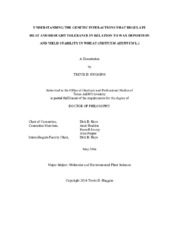| dc.description.abstract | Wheat (Triticum aestivum L.) has been a major food crop for nearly 8000 years.
Breeders continue to face an ongoing battle to produce stress tolerant cultivars that are
able to feed a rapidly increasing global population. The ability of varieties to perform
similarly in grain yield across various environments is an important trait that is critical to
successfully keep up with food demands with decreasingly available arable lands. The
work described in this dissertation focused on defining and understanding the genetic
interactions of epicuticular wax and high temperature and drought tolerance and its
association with yield stability, to better aid breeders in stress tolerance selection. The
effect of high temperature on epicuticular wax, yield attributes and yield stability were
investigated in a recombinant inbred line population of 180 individuals from a Halberd x
Len cross by physiological and molecular techniques.
Epicuticular wax offers advantages in protecting the plant from both biotic and
abiotic stresses. Under HT conditions, EWL can reduce chlorophyll fluorescence by
reflecting excess irradiation and also reduce stomatal conductance, helping to regulate
the rate of transpiration. QTL for epicuticular wax with large effects were detected on
chromosomes 2A, 2B, 3A, 6B, and 7A. A large effect QTL for epicuticular wax was
detected in three field environments on chromosome 2B (QWax.tam-2B.1) with the
favorable alleles contributed by Halberd. QTL for yield stability and yield components
stability indices with large effects were detected on chromosomes 1A, 1B, 2A, 2B, 3B,
6B, and 7A. A large effect QTL for yield stability was detected by five stability statistics over diverse field environments on chromosome 1B (Qyieldss.tam-1B) with Halberd
contributing the favorable alleles. High EWL may promote stable yields but its
sensitivity to environmental conditions makes it challenging to definitively point to it as
a source of improved stability. Although there were mixed relationships with yield
performance and environments, the stability statistics QTL provide strong evidence that
genetic variation may be heritable and could have implications for breeding programs
targeting a set of environments rather than a single environment. | en |


